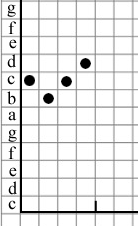How does one create a melody? It’s an interesting question with a lot of possible answers. For years, I tended to noodle around on guitar until I discovered a riff or chord progression I liked. Then I would basically just hear a melody in my head that would fit the guitar part. I really didn’t put much thought into it.
Other people have a much more hands on approach to melody creation. Jimmy Webb has book entitled “Tunesmith” (well worth a read) and he describes a rather detail oriented process of developing melodies and tweaking things until they are perfect.
Recently I’ve been thinking about a different way to approach melody writing. It’s a very visual approach. Here’s a simplified description.
First, start off with a piece of graph paper. Create and X and Y axis. On your Y axis, label the notes of the C major scale as shown below. On your X axis, think of each square as a beat in a 4/4 meter. Mark off every 4 beats for clarity, as shown below.

What we want to do here is overlay some melody shapes on top of this graph. What to I mean by melody shapes? Take a look at the following.

Each dot represents a note. In this case, each note is one beat long. The shape describes a melodic flow. You start with a note, then go down one note, then return to the original note and then go up one note.
Now, you can place the shape on your graph (by drawing it in for example) and it implies a melody. But the melody changes depending on where you place it. For example, this shows the melody C, B, C, D

But this shows melody A, G, A, B

So the same shape can be used to describe different melodic “chunks.”
What’s the point of all this? You’ll find as you examine most melodies in songs that they only use a limited amount of melodic shapes. This enforces a certain recognizability to a tune. As opposed to a melody that wanders about, introducing new elements all the time, the repeated use of a few shapes glues everything together. The shapes are kind of like the DNA of the song.
I’ve found that by playing around with a few shapes I can almost always come up with a decent sounding tune—not necessarily a hit, but something that sounds like music.
There are a few more considerations when playing with this idea and I’ll get into them in a later post. Obviously this process can be adjusted to handle concepts like chromatic as opposed to diatonic melodies, and beats smaller than quarter notes. But feel free to take this basic premise for a spin and see what you come up with.
great. The next bit is harmonizing the melodic phrase